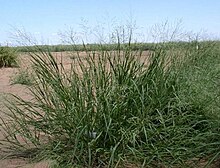| Panicum coloratum | |
|---|---|

| |
| Scientific classification | |
| Kingdom: | Plantae |
| Clade: | Tracheophytes |
| Clade: | Angiosperms |
| Clade: | Monocots |
| Clade: | Commelinids |
| Order: | Poales |
| Family: | Poaceae |
| Subfamily: | Panicoideae |
| Genus: | Panicum |
| Species: | P. coloratum |
| Binomial name | |
| Panicum coloratum L. | |
Panicum coloratum is a species of grass known by the common names kleingrass, blue panicgrass (USA), white buffalograss (southern Africa); Bambatsi panic, makarikari grass, and coolah grass (Australia). It is native to Africa, and it has been introduced elsewhere, such as the United States and Australia, and bred into many cultivars.
This plant is variable in appearance. In general, is a perennial bunchgrass which usually has rhizomes. The firm, mostly upright stems grow up to 1.4 m (4.6 ft) tall. The leaf blades are 10 to 30 cm (3.9 to 11.8 in) long. They are green to a waxy blue-green color. The panicles are variable in length. The spikelets are green and purple.
This grass is used as a pasture grass and to make hay. It produces a large amount of forage for animals. It is drought-tolerant and does well in hot climates. This C4 plant can grow on saline soils and requires some of sodium for effective photosynthesis. Different cultivars have varying tolerances of sodium. While it makes a good graze for most animals, the grass has occasionally been associated with liver damage and photosensitivity in young ruminants and horses. This photosensitivity can lead to sunburn, which causes swelling of the head and ears of the animal, a condition commonly called "swellhead".
Cultivars include 'Pollock', 'Bambatsi', 'Bushman Mine', 'Verde', and 'Kabulabula'.
References
- ^ Panicum coloratum. Tropical Forages.
- ^ Bambatsi Panic. Government of Western Australia Department of Agriculture and Food.
- ^ Panicum coloratum. USDA NRCS Plant Fact Sheet.
- ^ Panicum coloratum. Archived 2012-12-15 at archive.today Grass Manual Treatment.
- Blake, C. Kleingrass gains ground in desert ag. Western Farm Press September 3, 2009.
- Behling, A. Kleingrass catches on. Archived 2010-11-25 at the Wayback Machine Hay and Forage Grower February 1, 2001.
- Murata, S. and J. Sekiya. (1992). Effects of sodium on photosynthesis in Panicum coloratum. Plant Cell Physiol 33(8) 1239-42.
- ^ Matoh, Tōru; Murata, Shinji (1 April 1990). "Sodium Stimulates Growth of Panicum coloratum through Enhanced Photosynthesis". Plant Physiology. 92 (4): 1169–1173. doi:10.1104/pp.92.4.1169. PMC 1062431. PMID 16667386.
- Seffino, L. García (September 1998). "Salinity effects on the early development stages of Panicum coloratum : cultivar differences". Grass and Forage Science. 53 (3): 270–278. doi:10.1046/j.1365-2494.1998.00139.x.
- Hepatotoxic Plants. Merck Veterinary Manual.
- Bridges, C. H.; Camp, B. J.; Livingston, C. W.; Bailey, E. M. (November 1987). "Kleingrass ( Panicum coloratum L.) Poisoning in Sheep". Veterinary Pathology. 24 (6): 525–531. doi:10.1177/030098588702400609. PMID 3455080. S2CID 29404698.
- Sheep, goat producers should watch for kleingrass problems. Archived 2015-08-28 at the Wayback Machine Livestock Weekly
External links
- USDA Plants Profile
- Cornick, JL; Carter, GK; Bridges, CH (15 October 1988). "Kleingrass-associated hepatotoxicosis in horses". Journal of the American Veterinary Medical Association. 193 (8): 932–5. PMID 3192474.
| Taxon identifiers | |
|---|---|
| Panicum coloratum |
|